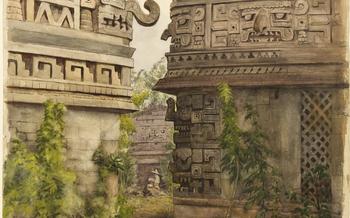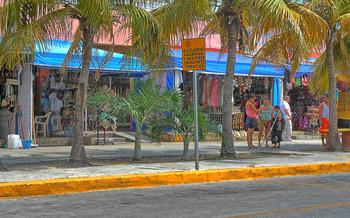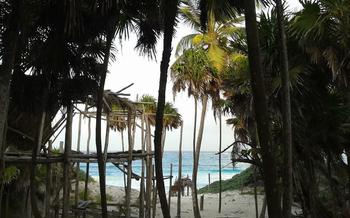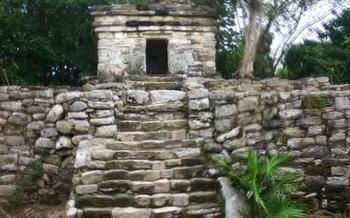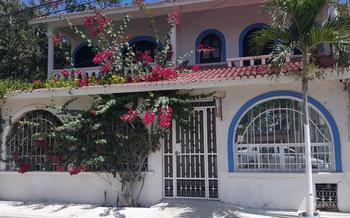
Cenote Dos Ojos
- Cenote Dos Ojos: An Overview
- Exploring the Cenote's Unique Features
- Snorkeling and Diving in Cenote Dos Ojos
- Other Activities at Cenote Dos Ojos
- Cenote Dos Ojos for Photography Enthusiasts
- Visiting Cenote Dos Ojos with Kids
- Local Cuisine and Dining Options
- Cultural Experiences and Mayan History
- Sustainable Tourism Practices
- Planning Your Visit: When to Go and What to Bring
- Getting There: Transportation Options
- Unique Souvenirs from Cenote Dos Ojos
- Capturing the Essence of Cenote Dos Ojos
- Insider Tip: Hidden Gems Near Cenote Dos Ojos
Cenote Dos Ojos: An Overview
Cenote Dos Ojos, meaning "Two Eyes Cenote," is a natural wonder located near Tulum, Mexico. It is part of the Sac Actun system, the world's largest underwater cave system, and is renowned for its crystal-clear waters, stunning stalactite and stalagmite formations, and diverse underwater life.
The cenote's name derives from its two distinct cenotes, "The Eye" and "The Bat Cave," which are connected by a narrow underwater passage. The Eye is a large, open cenote with a depth of over 30 meters, while the Bat Cave is a smaller, more enclosed cenote known for its impressive bat colonies.
A visit to Cenote Dos Ojos offers a unique and unforgettable experience for travelers seeking adventure, nature, and cultural immersion. Whether you're a snorkeling enthusiast, a certified diver, or simply looking to relax in a breathtaking natural setting, Cenote Dos Ojos has something to offer everyone.
Tips for Planning Your Trip:
- Advance booking is recommended, especially during peak season.
- Arrive early to avoid crowds and secure a spot in the shade.
- Bring cash as it is the preferred method of payment for entrance fees and activities.
- Wear comfortable clothing and water shoes for easy navigation around the cenote.
- Don't forget your swimsuit, sunscreen, and a towel.
- Consider bringing a waterproof camera to capture your underwater adventures.
Exploring the Cenote's Unique Features
Cenote Dos Ojos stands out for its two distinct cenotes: "The Eye" and "The Bat Cave." The Eye is a large, open cenote with crystal-clear waters that offer unparalleled visibility for snorkeling and diving. The Bat Cave, on the other hand, is a smaller, more enclosed cenote that is home to a colony of bats.
The underwater world of Cenote Dos Ojos is a feast for the eyes. The clear waters allow for breathtaking visibility, revealing a diverse ecosystem of stalactites and stalagmites in various shapes and sizes. The cenote is also home to a variety of aquatic life, including fish, turtles, and even the occasional crocodile.
For cave exploration enthusiasts, Cenote Dos Ojos offers a unique opportunity to swim through its vast network of underground chambers and tunnels. These caves are adorned with impressive stalactite and stalagmite formations, creating an otherworldly landscape that is sure to captivate any adventurer.
Snorkeling and Diving in Cenote Dos Ojos
Cenote Dos Ojos is a haven for snorkeling and diving enthusiasts, offering an unparalleled underwater experience. Several reputable tour operators provide guided snorkeling and diving tours, catering to different skill levels and interests.
For snorkelers, the crystal-clear waters offer exceptional visibility, allowing you to explore the cenote's intricate underwater world. Snorkelers can marvel at the diverse marine life, including colorful fish, turtles, and rays, as they glide through the cenote's crystal-clear waters.
Divers, on the other hand, can delve deeper into the cenote's hidden depths. The two cenotes, "The Eye" and "The Bat Cave," offer unique diving experiences. "The Eye" features a large cavern with stalactites and stalagmites, while "The Bat Cave" is home to a colony of bats and offers a thrilling adventure for experienced divers.
During your dive, keep an eye out for ancient Mayan artifacts and fossils, which occasionally surface from the cenote's depths. These discoveries provide a glimpse into the region's rich history and cultural heritage.
To enhance your snorkeling or diving experience, consider bringing your own equipment if possible. This allows you to customize your gear and ensure a comfortable fit. Additionally, remember to bring an underwater camera to capture the stunning beauty of the cenote's underwater world.
Other Activities at Cenote Dos Ojos
In addition to snorkeling and diving, Cenote Dos Ojos offers a range of other exciting activities that allow you to explore its natural beauty from different perspectives.
-
Guided Cave Tours: Embark on a guided cave tour to discover the hidden chambers and formations within the cenote. These tours are suitable for non-divers and provide a unique opportunity to learn about the geology and history of the cenote.
-
Zip-lining Adventures: Experience the thrill of zip-lining through the lush jungle canopy, soaring over the crystal-clear waters of the cenote. Multiple zip-line courses are available, catering to different skill levels and offering breathtaking views.
-
Kayaking and Paddleboarding: Glide across the tranquil waters of the cenote in a kayak or on a stand-up paddleboard. This is a great way to explore the cenote's serene surroundings and spot wildlife along the way.
-
Jungle Hiking Trails: For nature enthusiasts, Cenote Dos Ojos offers a network of well-maintained hiking trails that wind through the surrounding jungle. These trails provide a chance to encounter diverse flora and fauna and immerse yourself in the area's natural beauty.
Cenote Dos Ojos for Photography Enthusiasts
Cenote Dos Ojos offers a photographer's paradise, with its crystal-clear waters and abundant natural beauty. The cenote's unique underwater world provides a stunning backdrop for capturing breathtaking images. Whether you're an experienced underwater photographer or just starting, here are some tips to help you capture the essence of Cenote Dos Ojos:
-
Embrace Natural Light: The cenote's natural light creates a magical ambiance, especially during the early morning or late afternoon hours. Position yourself to utilize the sunlight's direction, creating dramatic shadows and highlights.
-
Choose the Right Equipment: Invest in a good underwater camera or waterproof housing for your DSLR. A wide-angle lens is ideal for capturing the cenote's vastness, while a macro lens will allow you to focus on the intricate details of the underwater ecosystem.
-
Experiment with Different Angles: Don't limit yourself to shooting from the surface. Dive down and capture shots from various angles, including underwater and surface-level perspectives. Experiment with different vantage points to create unique and dynamic compositions.
-
Capture the Underwater World: The cenote's crystal-clear waters offer unparalleled visibility, allowing you to capture stunning shots of the diverse underwater ecosystem. Look for vibrant coral formations, colorful fish, and ancient Mayan artifacts.
-
Share Your Experiences: Share your underwater photography experiences with the world! Post your photos on social media, create a blog to showcase your work, or participate in underwater photography contests. Inspire others to explore the wonders of Cenote Dos Ojos through your lens.
Visiting Cenote Dos Ojos with Kids
Planning a visit to Cenote Dos Ojos with kids? Here's how to make it a memorable and enjoyable experience for the whole family.
When visiting Cenote Dos Ojos with kids, safety and age-appropriateness are top priorities. The cenote's calm waters and shallow areas make it suitable for young swimmers and snorkelers. Life jackets are provided for added safety, and parents should supervise children closely at all times.
For younger children, snorkeling is an excellent way to explore the cenote's crystal-clear waters. Guided tours are available, providing a safe and informative experience for kids of all ages. These tours often include equipment rental, making it convenient for families.
To keep kids engaged and entertained, consider exploring the cenote's surroundings. Jungle trails offer opportunities for family hikes, where kids can discover the diverse flora and fauna of the region. Zip-lining adventures through the lush canopy are another thrilling activity that older children may enjoy.
Educational experiences can also be incorporated into the visit. Teach kids about Mayan history and culture, explaining the significance of cenotes in ancient Mayan society. Encourage them to observe the unique rock formations and diverse aquatic life, fostering an appreciation for the natural world.
Remember to pack snacks, drinks, and sun protection for the family. A picnic lunch amidst the cenote's natural beauty can be a delightful experience. For longer visits, consider renting a private cabana to relax and enjoy the surroundings.
With careful planning and supervision, a visit to Cenote Dos Ojos can be an unforgettable adventure for families, creating lasting memories and fostering a love for nature and exploration in young minds.
Local Cuisine and Dining Options
When visiting Cenote Dos Ojos, don't miss the opportunity to indulge in the authentic flavors of Mexican cuisine. Several restaurants and cafes near the cenote offer a range of culinary delights that will tantalize your taste buds. From traditional Mexican dishes to international favorites, there's something for everyone to enjoy.
For an authentic Mexican experience, try the local specialty, cochinita pibil, a slow-roasted pork dish cooked in banana leaves. Another must-try is tacos al pastor, succulent grilled pork tacos served with pineapple and salsa. If you prefer seafood, sample the ceviche, a refreshing dish made with fresh fish or shrimp marinated in lime juice and spices.
For a more laid-back dining experience, pack a picnic lunch and enjoy it amidst the natural surroundings of the cenote. Find a shady spot under the trees and savor your meal while taking in the breathtaking views.
For those with dietary restrictions, there are plenty of vegetarian and vegan-friendly options available. Many restaurants offer dishes made with fresh local produce, so you're sure to find something delicious and satisfying.
Here are some additional tips for finding the best dining options near Cenote Dos Ojos:
-
Ask locals for recommendations. They often know the best places to eat that aren't listed in guidebooks.
-
Look for restaurants that use fresh, local ingredients. This is a sign that the food will be of high quality.
-
Don't be afraid to try new things. Mexican cuisine is full of unique and delicious flavors that you might not have experienced before.
-
Enjoy your meal! Mexican food is meant to be savored and shared with friends and family.
Cultural Experiences and Mayan History
Cenotes held deep cultural significance for the ancient Mayans. They believed these natural wonders were portals to the underworld and sacred places for rituals and ceremonies. Cenote Dos Ojos was particularly revered and was considered a place of spiritual purification and connection with the gods.
Historical anecdotes and legends associated with the cenote add to its allure. One famous legend tells of a young Mayan warrior who was chosen by the gods to protect the cenote from evil spirits. He was given a magical spear that allowed him to defeat the spirits and maintain the cenote's sacredness.
Opportunities to learn about Mayan traditions and customs abound in the area surrounding Cenote Dos Ojos. Guided tours often incorporate Mayan history and culture, and visitors can explore nearby Mayan ruins and museums to gain a deeper understanding of this ancient civilization.
Respecting and preserving the cultural heritage of the region is essential when visiting Cenote Dos Ojos. Visitors should be mindful of their behavior and actions, avoiding any disrespect to the Mayan culture and its sacred sites. By embracing the cultural experiences and learning about the Mayan history associated with Cenote Dos Ojos, visitors can create a more meaningful and enriching connection with this natural wonder.
Sustainable Tourism Practices
Cenote Dos Ojos, like many natural wonders, is susceptible to the impacts of tourism. As responsible travelers, we must prioritize sustainable practices to preserve its pristine beauty for generations to come. Here are some ways to minimize your environmental impact and support the local community:
-
Respect the Environment: Avoid touching or damaging the cenote's delicate rock formations and ecosystem. Refrain from using harsh chemicals or sunscreens that can harm the water quality. Dispose of trash properly in designated bins.
-
Support Local Businesses: Choose local tour operators and guides who adhere to sustainable practices. By supporting local businesses, you contribute to the economic well-being of the community and ensure that tourism benefits everyone.
-
Reduce Plastic Waste: Bring your own reusable water bottle and containers to avoid single-use plastics. Opt for eco-friendly souvenirs made from sustainable materials.
-
Educate Yourself and Others: Learn about the cenote's ecosystem and its cultural significance. Share your knowledge with fellow travelers and encourage them to adopt responsible tourism practices.
-
Respect the Mayan Culture: Remember that the cenote is a sacred site for the Mayan people. Be respectful of their traditions and customs, and avoid any behavior that may be considered disrespectful.
Planning Your Visit: When to Go and What to Bring
Timing your visit to Cenote Dos Ojos is crucial for an optimal experience. The best time to visit is during the dry season, which runs from November to April. During this period, you'll encounter sunny skies, clear visibility underwater, and fewer crowds.
Pack accordingly for your cenote adventure. Swimwear, a towel, and a change of clothes are essential. Don't forget your sunscreen, sunglasses, and a hat to protect yourself from the sun's intense rays. Insect repellent is also recommended, especially during the rainy season.
To capture the cenote's beauty, bring a waterproof camera or an underwater housing for your phone. Remember your charger and extra batteries to avoid missing any photo opportunities.
For a comfortable experience, consider bringing water shoes or sandals for navigating the cenote's rocky terrain. A flashlight can be handy for exploring the darker corners of the caves.
If you plan to spend the day at the cenote, pack a picnic lunch and snacks to enjoy amidst the natural surroundings. Alternatively, there are a few restaurants and cafes nearby where you can grab a bite to eat.
To avoid crowds and ensure a peaceful experience, aim to visit the cenote early in the morning or late in the afternoon. Keep in mind that the cenote can get quite busy during peak tourist season, so plan accordingly.
Finally, remember to stay hydrated, especially in the hot and humid climate. Drink plenty of water before, during, and after your visit to the cenote to prevent dehydration.
Getting There: Transportation Options
Reaching Cenote Dos Ojos from Cancun or Playa del Carmen is a breeze. If you prefer the freedom of self-exploration, renting a car is the way to go. The drive from Cancun takes about an hour and 45 minutes, while from Playa del Carmen, it's approximately an hour. Along the way, you'll be treated to stunning views of the Riviera Maya's lush landscapes.
For those without a rental car, taxis are readily available. Expect to pay around $100 for a round trip from Cancun or $50 from Playa del Carmen. For a more budget-friendly option, hop on a colectivo, a shared van that runs regularly between Cancun and Tulum. Simply ask the driver to drop you off at the entrance to Cenote Dos Ojos.
If you prefer a hassle-free experience, book a guided tour that includes transportation. These tours typically depart from major hotels and often combine a visit to Cenote Dos Ojos with other nearby attractions, such as Tulum or Chichen Itza.
No matter how you choose to get there, make sure to allow ample time for your journey, especially if you're driving during peak tourist season.
Unique Souvenirs from Cenote Dos Ojos
Discover the Essence of the Cenote Through its Handmade Crafts
Your visit to Cenote Dos Ojos will undoubtedly leave an imprint on your heart. As you plan your return home, you may want to take a piece of the cenote's magic with you. Look no further than the local artisans who create exquisite souvenirs inspired by the cenote's natural beauty.
In the shops and stalls near the cenote, you'll find a treasure trove of handcrafted items that capture the essence of Cenote Dos Ojos. From intricate jewelry adorned with semi-precious stones to hand-painted pottery featuring the cenote's unique underwater scenes, each souvenir is a testament to the region's rich cultural heritage.
When choosing your souvenirs, opt for those made from sustainable materials and by local artisans. This way, you'll not only support the local economy but also contribute to preserving the cultural traditions of the region.
Consider purchasing a handmade necklace or bracelet adorned with turquoise and jade, reminiscent of the cenote's crystal-clear waters. Or choose a hand-carved wooden figurine depicting a Mayan diver, paying homage to the cenote's ancient history.
As you share these unique souvenirs with friends and family back home, you'll not only bring them a tangible piece of Cenote Dos Ojos but also a story of cultural richness and environmental consciousness.
Capturing the Essence of Cenote Dos Ojos
My encounter with Cenote Dos Ojos was an awe-inspiring experience that left an indelible mark on my soul. Floating amidst the crystal-clear waters, surrounded by ancient rock formations and vibrant aquatic life, I felt a profound connection to the natural world. The cenote's beauty transcended mere aesthetics; it evoked a sense of wonder, tranquility, and a deep appreciation for the Earth's hidden treasures.
Beyond its physical allure, Cenote Dos Ojos holds cultural and historical significance, serving as a sacred site for the ancient Mayans. As I explored the cenote's depths, I couldn't help but feel a connection to the past, imagining the rituals and ceremonies that once took place within its hallowed chambers. The cenote's aura of mystery and spirituality added an enchanting layer to my experience, making it more than just a swimming hole—it was a portal to another realm.
Sharing my memories of Cenote Dos Ojos with fellow travelers brings me immense joy. I love recounting the thrill of diving into the cenote's depths, the exhilaration of spotting exotic fish and ancient artifacts, and the serenity of floating in the crystal-clear waters. Through my stories and photographs, I hope to inspire others to embark on their own cenote adventures and to cherish the natural wonders that our planet holds.
The essence of Cenote Dos Ojos lies in its ability to transport visitors to a realm of wonder and tranquility. It is a place where time stands still, where the only sounds are the gentle lapping of water against the cave walls and the chirping of birds overhead. It is a place where one can connect with nature, with history, and with oneself. If you are seeking an experience that will stay with you long after you've left, then Cenote Dos Ojos is the place for you.
Insider Tip: Hidden Gems Near Cenote Dos Ojos
While Cenote Dos Ojos is a must-visit destination, the surrounding area offers a wealth of hidden gems waiting to be discovered. For those seeking a more secluded experience, Cenote Cristalino, located just a short distance away, boasts crystal-clear waters and a peaceful ambiance. Another hidden gem is the nearby town of Tulum, renowned for its ancient Mayan ruins, stunning beaches, and vibrant nightlife.
For those seeking adventure, the Aktun Chen Natural Park offers a unique opportunity to explore a network of underground rivers and caves, providing a thrilling experience for nature enthusiasts. Additionally, the Sian Ka'an Biosphere Reserve, a UNESCO World Heritage Site, is a haven for biodiversity and offers breathtaking landscapes, including pristine beaches, lush jungles, and diverse wildlife.
To create a personalized itinerary, consider combining a visit to Cenote Dos Ojos with exploring these nearby attractions. Allocate ample time to fully immerse yourself in the beauty and wonders of this region. Remember to respect the local culture and environment, and always prioritize sustainable tourism practices.
